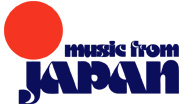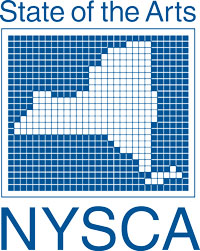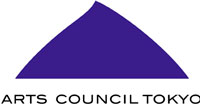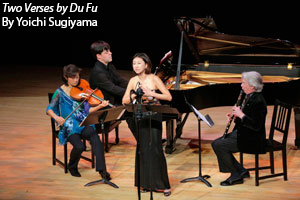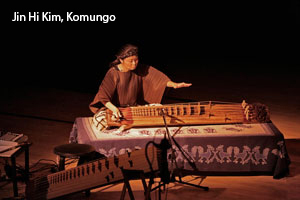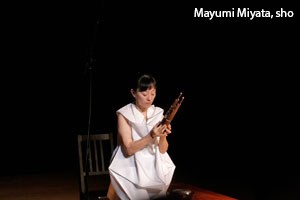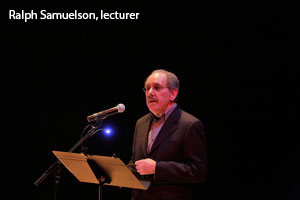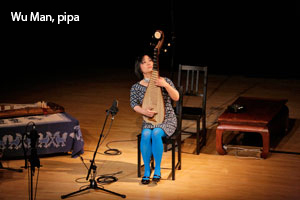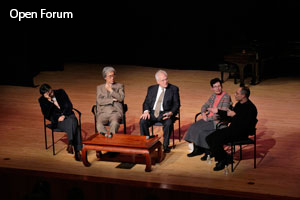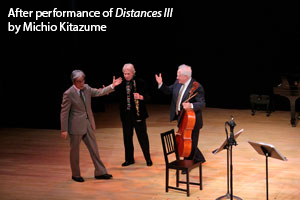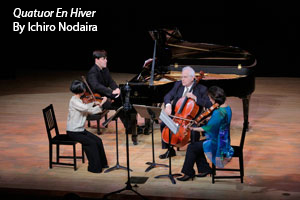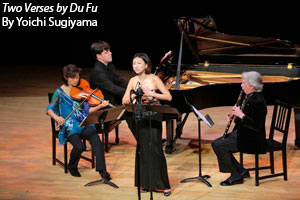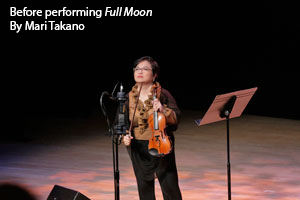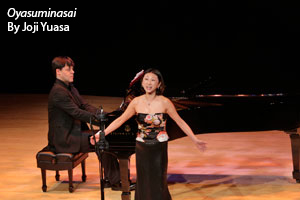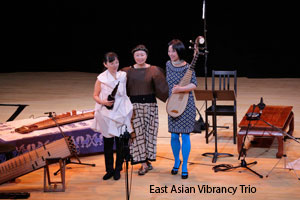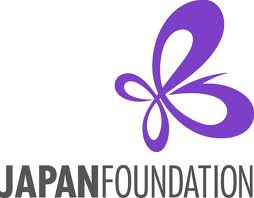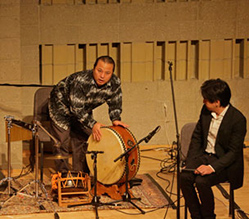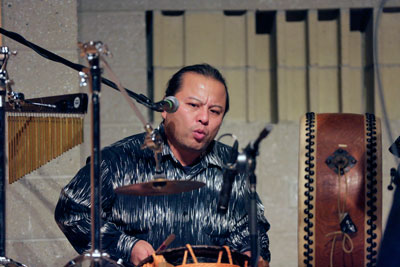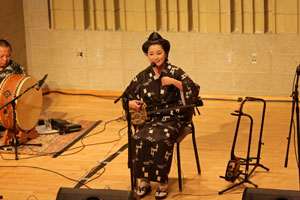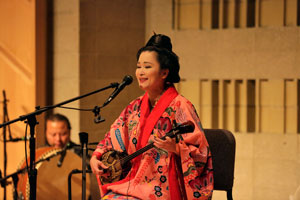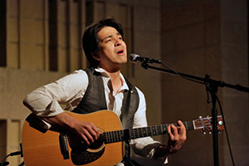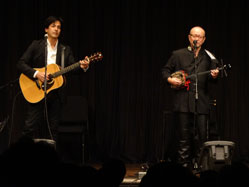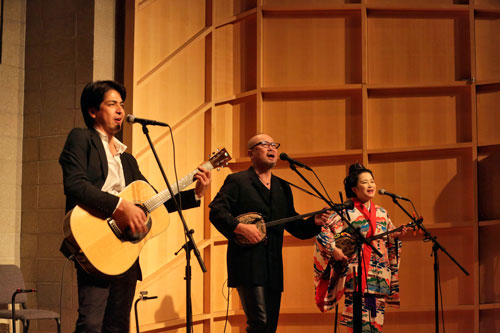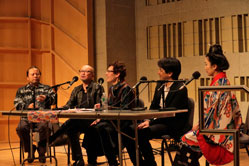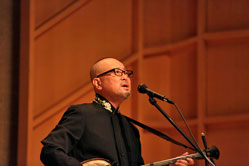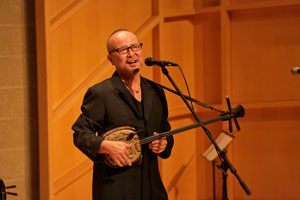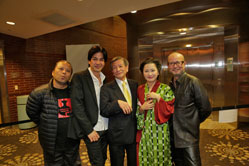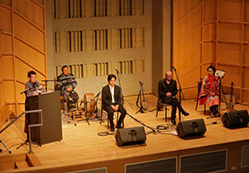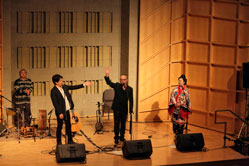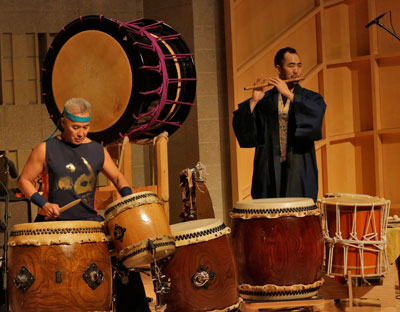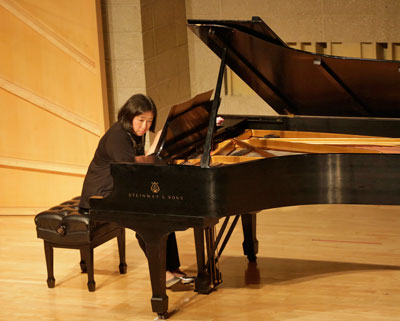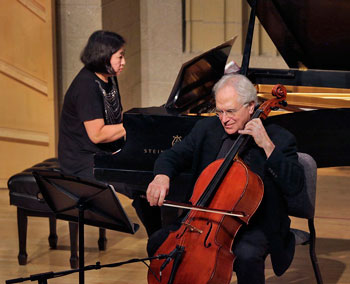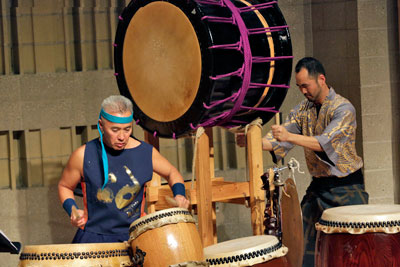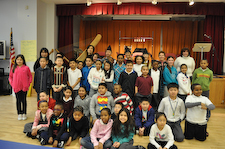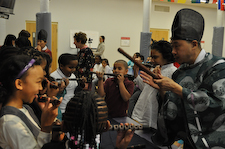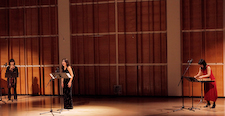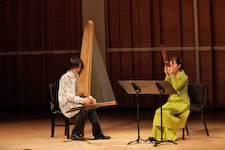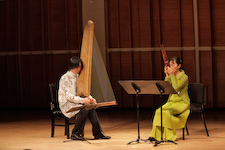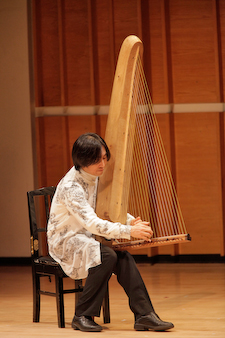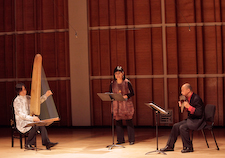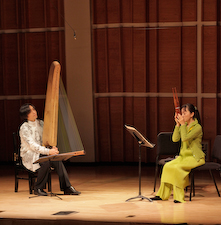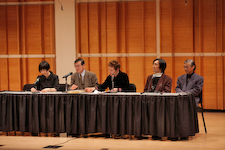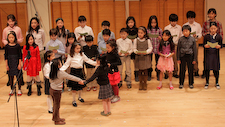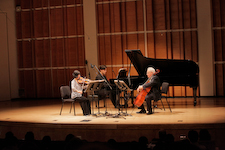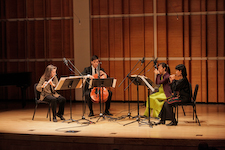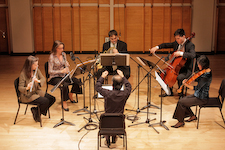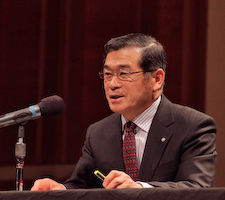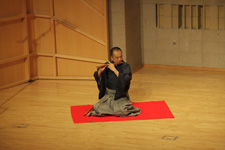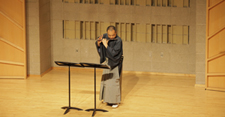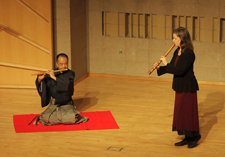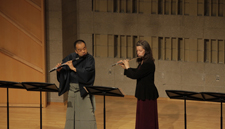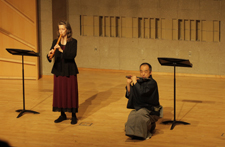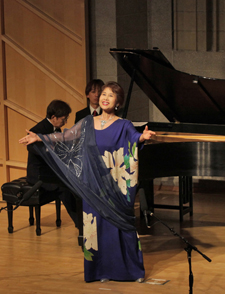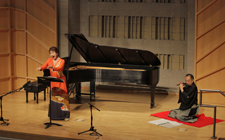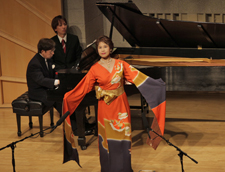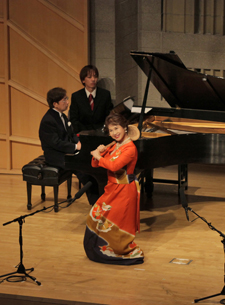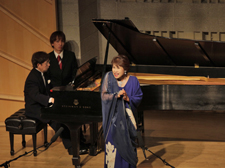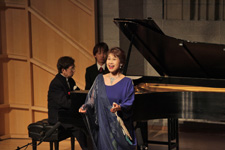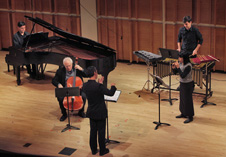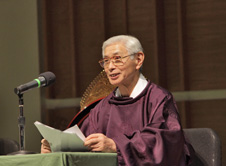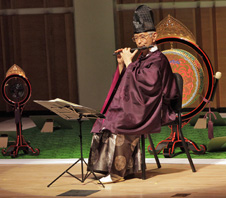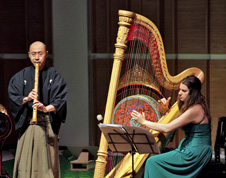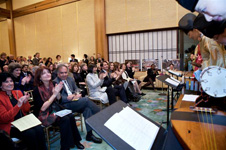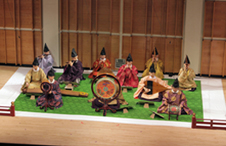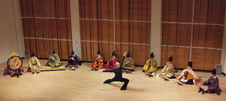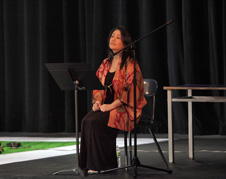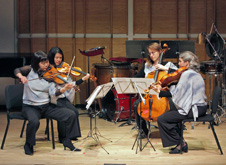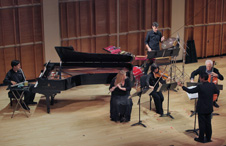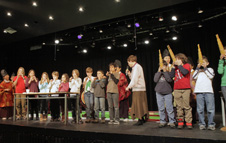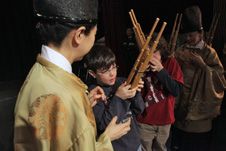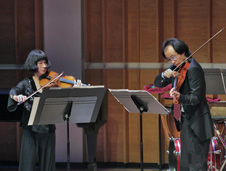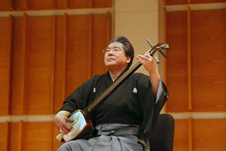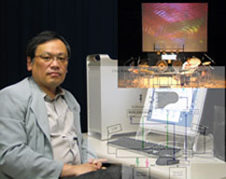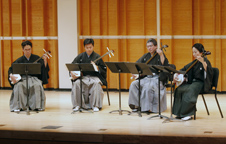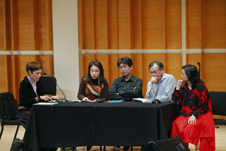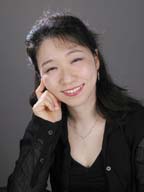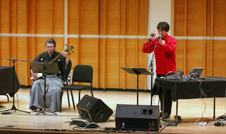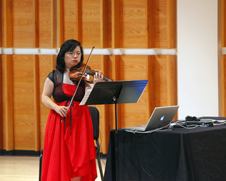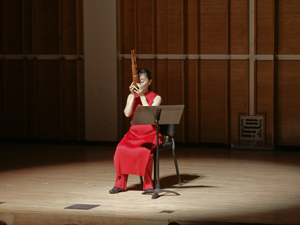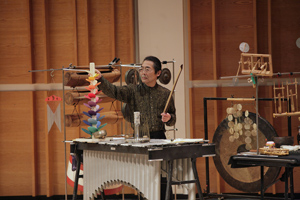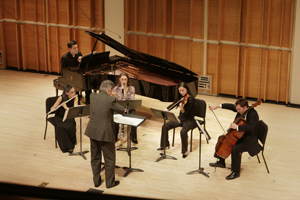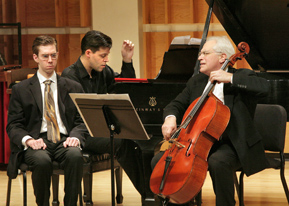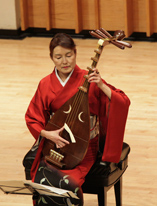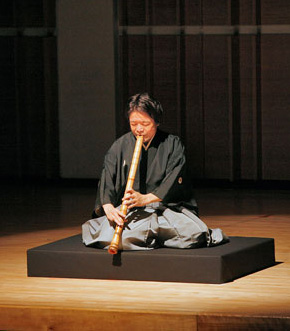
All photos by Ken Howard unless otherwise noted
40th ANNIVERSARY FESTIVAL
East Asian Vibrancy and
Highlights of MFJ Commissions III
New York City Festival at the Asia Society
February 7th: East Asian Vibrancy
February 8th: Highlights of MFJ Commissions III
New York Brochure
Washington DC at Freer Gallery of Art
February 10th: East Asian Vibrancy
Fukushima City at Fukushima City Concert Hall
March 6th: East Asian Vibrancy
Fukushima Brochure
Tokyo at Bunka Kaikan Recital Hall
March 7th: Highlights of MFJ Commissions Tokyo
March 8th: East Asian Vibrancy
Tokyo Brochure
View the complete program listings
The New York and Washington DC chapters of Music From Japan’s 40th Anniversary were celebrated with unique cross-cultural exchange between the US, Japan, and its neighboring nations: China and Korea. On February 7th, for East Asian Vibrancy, three world class performers of East Asian traditional instruments performed contemporary and classical repertoire. The program was dedicated to Beate Sirota Gordon, who, as the Director of the Performing Arts at both the Asia Society and the Japan Society, helped Music From Japan organize its first events. Geoffrey Gordon, Beate’s son, was in attendance. On February 8th, Highlights of Music From Japan Commissions III featured highlights of past Music From Japan commissions presented alongside the world premieres of two new pieces by Japanese composers.
The festival began with a lecture called Exploring the Music of East Asia by scholar and shakuhachi player Ralph Samuelson on the music of East Asia and the connections between the instruments found throughout the entire Asian continent. He explained how instruments traveled along the Silk Road, which became an important travel route for ideas and culture as well as goods. He also pointed out an important event when, in 749, for the dedication of the temple of Todai-ji, musicians from all over Asia traveled to Japan to perform. The instruments they brought with them would then be adopted, slightly modified, renamed, and become the basis of the ensemble for gagaku, the imperial court music of Japan. Sonically, Mr. Samuelson explained, tone color plays an extremely important role in the music of Eastern Asia—more so than in western music. He also explained that in Eastern Asian music there traditionally is no clear separation between composer and performer. Instrumentalists play the role of both composer and interpreter, and typically the tradition of committing music to writing at all only served as a memory aid rather than some kind of definitive manuscript.
After the lecture and a short break, Rachel Cooper, the Director of Performing Arts at the Asia Society, took the stage and commented on the power of music and culture in general to facilitate understanding and diplomacy between nations— certainly not a farfetched claim, especially considering the full house included many dignitaries, including UN Ambassadors from Papua New Guinea, Korea, Cambodia, and Japan.
Mayumi Miyata opened the concert with the piece Hyojo no choshi, a traditional piece for sho, one of the wind instruments used in gagaku. The piece is traditionally played as a prelude, and conjures up a particular mood or color in the audience’s mind. Before beginning, Mayumi dedicated the performance to Music From Japan. The piece itself featured long sustained overlapping tones, the pitches sometimes creating harmonic beats—a kind of wavering effect caused by the closeness of the intervals.
Next, Jin Hi Kim performed Dasrum, also a kind of prelude for another ancient East Asian musical form, in this case kagok, a type of Korean vocal music. The piece was slow and meditative, often with significant space left between each gesture. Wu Man then took the stage, wielding her pipa and first performing Xi Yang Xiao Gu (Flute and Drum Music at Sunset). She graced the audience with a flurry of fast tremolo, overset by beautiful melodic lines.
To begin the contemporary portion of the program Wu Man performed two of her original pieces. Night Thoughts was slow and melancholic, featuring lilting augmented seconds and chromatic passages punctuated by silence. Leaves Flying in Autumn lay at the opposite pole, featuring furious tremolo and fast virtuosic lines.
Mayumi Miyata returned to the stage, this time performing Yumi Saiki’s piece Entomophonie VII, which was inspired by insect sounds. Indeed, the performance at times was reminiscent of sounds of the forest: long tones were punctuated by quick chirps and punchy dissonant chords.
Jin Hi Kim then performed on her electric komungo, a modified version of the instrument, manipulated by computer electronics. She immersed the audience in a soundscape of lush textures as she used a variety of extended techniques, including using a bow on the instrument, which is traditionally plucked.
After intermission the three musicians came together in an extended improvisation. The three women spontaneously created some exciting music that was at times sparse and with a fluid sense of time, at other moments dense and upbeat.
Finally, the three performed Unkai the MFJ-commissioned piece by Ned Rothenberg. The piece artfully orchestrated this unique configuration, employing seamlessly both traditional and contemporary instrumental techniques. The ancient spirits of the instruments were evoked, but at the same time the sonic palettes of each were expanded into new realms, both individually and as an ensemble.
In total, the evening was a wonderful blend of instruments, styles, and techniques. No one could have achieved this better than Mayumi Miyata, Jin Hi Kim, and Wu Man, each known in their own right for expanding the repertoire and pushing the boundaries of these three traditional instruments.
The second day, Highlights of Music From Japan Commissions III, began with Quatuor En Hiver, a piece by Ichiro Nodaira. The piece featured Stephen Gosling on piano, Fred Sherry on cello, Ah Ling Neu on viola, and Eriko Sato on violin. Musically, the piece vacillated between punchy and percussive fragments and longer sustained gestures. It seemed Mr. Nodaira was often treating the ensemble—especially the trio of strings—as a single instrument, with lines, specific pitches and gestures bouncing between the violin, viola, and cello freely.
Next, Mari Kimura expertly performed Mari Takano’s Full Moon, a piece for violin and electronics. The accompaniment, played from Kimura’s laptop, spanned the gamut between purely synthetic sounds and violin samples. The piece was energetic, dense, and polystylistic, showing off a wide range of timbres and techniques on the violin.
Distances III by Michio Kitazume, performed by Fred Sherry and Richard Stoltzman, was reductive and even elemental, using as its elements deconstructed phrases, tones, and sounds. The composer employed silence, trills, and glissandi to make for a brilliant dialogue between these two performers, who were facing each other seated close together on stage.
Oyasuminasai, a piece by Joji Yuasa and performed by Stephen Gosling on piano and Wonjung Kim on voice, was a break in an otherwise highly abstract program of music. Yuasa’s use of the piano and voice was relatively idiomatic, employing lush romantic harmonies in the piano and beautiful melodic lines for the soprano.
Two Verses by Du Fu for voice and instruments by Yoichi Sugiyama was composed in such a way that allowed the performers some flexibility in the unfolding of the piece. Rather than following a definitive pulse followed by all of the musicians at the same time, each performer proceeded independently from the others, working with durations that lacked a pulse. As such, the piece seemed improvisatory at times. Stylistically, the first movement was atonal and melancholic and the second movement employed a kind of busy dense texture among the instruments that would pause each time Wonjung entered with her voice.
The New York chapter of the festival was concluded by two open forums. The first was a conversation between Sharon Nakazato and Kotoko Fukunaka in which Ms. Fukunaka, who wrote a book on Music From Japan, discussed its historic importance. In particular, she placed an emphasis on the large scale projects that MFJ organized and took part in, such as the composer portraits and their collaboration with the New York City Opera on Kinkakuji in 1995.
The second forum brought all three commissioned composers onto the stage, along with interpreter Sharon Nakazato and cellist Fred Sherry. Mr. Sugiyama and Mr. Kitazume discussed what it meant to be a Japanese musician composing in a Western idiom. They both seemed to think that the issue of nationality wasn’t particular important, especially since from the beginning their musical training was not in classical Japanese music, but in Western art music. Rothenberg, who has had the very different experience of studying traditional Japanese music as an American (in addition to his studies in European and American music), summed up the general sentiment, explaining that musicians are a product of what they love, irrespective of nationality. It seems that in a time when international musical resources are so accessible, composers and performers can truly choose their own path, according to what interests them.
Both New York performances were favorably reviewed in the February 10th edition of the New York Times. Check out the article by clicking here.
On February 10th, the East Asian Vibrancy trio performed at the Freer Gallery in Washington DC, where they performed to a hall filled to capacity. As the musicians were more familiar with Rothenberg’s Unkai, the performance of the piece was even more nuanced than the premiere in New York, and so the trio enjoyed a well-deserved standing ovation.
![]()
© Music From Japan, Inc.

Songs of Okinawa
For its 39th season, Music From Japan presented music from Okinawa, the chain of islands that make up the southernmost prefecture of Japan. Naoyuki Miura, Music From Japan’s Artistic Director, worked closely with the band The Ryukyuans to develop a program of diverse Okinawan music in what would be their North American debut. The Ryukyuans performed a wide variety of traditional and contemporary songs, representing several of the many cultures and languages found in the expansive Ryukyuan archipelago. Each band-member’s own cultural heritage and music path is unique, yet they share an interest in contributing to the rich Okinawan folk-music tradition by breathing life into traditional songs and performing new works. The three-stringed sanshin, the quintessential Okinawan instrument, is central to the music of the Ryukyuans, as it has been central to Okinawan music for centuries.
The first concert was preceded by a lecture-demonstration led by Sharon Nakazato. Sharon began by sharing some background information about Okinawan music, language, and culture gleaned through her own research and from the Ryukyuans. Each musician then discussed the basics of his or her instrument and approach to voice.
In Songs of Okinawa: Tradition and Today, The Ryukyans performed folk songs from their respective cultural origins: Yukito Ara representing the Yaeyama region, Isamu Shimoji the Miyako region, and Shinobu Matsuda the Okinawa main island. Throughout much of the program these musicians were accompanied by Satoshi “Sunday” Nakasone who performed on the shima-daiko, the Okinawan version of Japanese percussion. The program began with Yunta Shoura, a traditional antiphonal song usually sung in the workplace or during celebrations; it was beautifully interpreted by Yukito and Isamu, who sang without accompaniment. Isamu then took the stage alone to perform songs from the Miyako region of Okinawa. The spare sanshin playing, coupled with longer vocal phrases, created an evocative, melancholic atmosphere. Next, Shinobu Matsuda, wearing a traditional Okinawan kimono, performed folk songs from the Okinawa main island. These pieces tended to be more upbeat, and featured a sanshin accompaniment that was more dance-like than the opening songs of the evening.
After intermission, the sound of waves on a beach created the setting for Yukito to take the stage. He shared songs characteristic of his birthplace, the Yaeyama Islands, as well as a Ryukyu dance song called Kanayo/Amakaa. The rest of the program offered more modern pieces, written from the middle of the 20th century through to today. Some of the songs had lyrics written by Isamu or Yukito, or music composed by Isamu, and all incorporated elements of American popular music while still bearing the stamp of Okinawan folk song. The evening ended with an encore entitled Honen Ondo or “Harvest Song” performed by the entire group. This number was upbeat and heavily influenced by American rock music. As the song neared its conclusion the tempo increased, making for a high-energy finale to a diverse night of music.
On Sunday, in New Songs of Okinawa, The Ryukyuans focused on more contemporary repertoire. The evening was, nonetheless, peppered with more traditional songs, including some reprised from the previous night, reminding listener and performer alike of the important connection to tradition that is still part of Okinawan popular music. In some of the newer pieces we could hear the strong influence of American popular song on modern Okinawan music: Jazzy Myahk was appropriately jazz-infused, and featured a section in which the lyrics were delivered rapidly on a single pitch, evoking the sound of American rap music; Last Waltz and That Summer Day, both sung with standard acoustic guitar, are beautiful modern ballads with melodic content similar to that of American love songs. The afternoon ended with two encores: Honen Ondo and Shidei Gafuu or “A Prayer for Blessing and Joy.” The latter was written especially for the 2014 Festival and commissioned by Music From Japan; with lyrics by Yukito and music by Isamu, it featured an energetic call and response between the members of the band.
The Sunday afternoon concert was followed by an open forum entitled “Creative Process and Language in Okinawa,” moderated and interpreted by Sharon Nakazato. Discussion topics included the backgrounds of the musicians, the many languages of Okinawa, and the process of writing culturally and politically responsible songs.
In Washington, DC, The Ryukyuans reprised their performance of Songs of Okinawa: Tradition and Today, and sang two encore pieces. The Washington Post spoke highly of the event, saying that the songs “were absolutely stunning in their spare, evocative and often plaintive beauty.”
© Music From Japan, Inc.

Music From Japan Festival 2013
Japanese Rhythm and Timbre
In Festival 2013, Music From Japan presented two concerts at the Baruch Performing Arts Center in New York. On February 23rd, Rhythms of Japanese Drums and Flutes featured Kenny Endo and Kaoru Watanabe performing on taiko and fue. The concert included new compositions, improvisations, and arrangements of traditional repertoire all performed to a sold-out concert hall. On February 24th, MFJ presented Kumi Ogano on piano and Fred Sherry on cello in Japanese Tone Colors on Western Instruments. They performed a series of contemporary Japanese pieces composed between 1969 and 2012, including a world premiere by Tomiko Kohjiba, commissioned by MFJ for the event. Kenny Endo and Kaoru Watanabe performed two more concerts as part of MFJ’s 2013 season: a repeat performance of Rhythms of Japanese Drums and Flutes at the Freer Gallery in Washington, DC, and a different program at Shapeshifter Lab in Brooklyn with Sumie Kaneko on koto and shamisen.
NYC (Feb 23-24) and Washington, DC (Feb 27)
Featured Artists:
Kenny Endo: taiko
Kaoru Watanabe: taiko and fue
Kumi Ogano: piano
Fred Sherry: cello
Tomiko Kohjiba: commissioned composer
–
Baruch Performing Arts Center
Engelman Recital Hall
Baruch College: East 25th Street between Lexington Avenue and 3rd Avenue
Rhythms of Japanese Drums and Flutes Kenny Endo and Kaoru Watanabe: Taiko and Fue
Sat, Feb 23, 2013 at 8pm Baruch Performing Arts Center (Engelman Recital Hall), New York City
Artists:
Kenny Endo, taiko (drums)
Kaoru Watanabe, taiko (drums) and fue (bamboo flutes)
Program:
Kenny Endo: Jugoya
Kaoru Watanabe: Together Alone
traditional: Chakuto Kenny Endo: Symmetrical Soundscapes ; Sand
Kaoru Watanabe: Hiraki Endo and Watanabe: Chigen
Kenny Endo: Spirit Sounds Kenny Endo: Swing, Soul and Sincerity
Arrangements of traditional pieces and new compositions/improvisations by Kenny Endo and Kaoru Watanabe.
Full program details to follow.
7:15pm: Pre-concert lecture-demonstration by Kenny Endo and Kaoru Watanabe
Japanese Tone Colors on Western Instruments
Sun, Feb 24, 2013 at 2pm Baruch Performing Arts Center (Engelman Recital Hall), New York City
Artists:
Kumi Ogano (piano) with Fred Sherry (cello)
Program:
Jummei Suzuki: Impromptu for piano solo (2007)**
Yoshio Hachimura: Meditation “Higan-bana” (1969)
Toru Takemitsu: For Away (1973); Les yeux clos (1979); Orion for cello and piano (1984)
Akira Miyoshi: Chaines – Preludes for piano (1973)
Tomiko Kohjiba: Wadatsumi for cello and piano (2012)*
** American premiere
* world premiere of new Music From Japan commission
3:45pm: Post-concert forum featuring Tomiko Kohjiba and the artists
Rhythms of Japanese Drums and Flutes — Kenny Endo and Kaoru Watanabe: Taiko and Fue
Wednesday, Feb 27th, 2013 at 7.30pm
Freer Gallery, Smithsonian Institution, Washington DC (same program as Feb 23 – see above)
Kenny Endo and Kaoru Watanabe Celebrate Release of Their New CD Convergence
with Special guest Sumie Kaneko
Tuesday, March 5th, 2013 at 7:30pm
Shapeshifter Lab, Brooklyn, NY
© Music From Japan, Inc.

Resonances of Kugo
Since its founding in 1975, Music From Japan has enriched the cultural life of New York with annual presentations of traditional and contemporary Japanese music, and Festival 2012 was no exception. However, in light of the trio of catastrophes suffered in Japan – the earthquake, tsunami, and nuclear disaster of 2011 – Music From Japan dedicated its 37th season to helping raise funds for and awareness of Iitate, one village that has been especially impacted by the nuclear calamity, and to which MFJ Artistic Director Naoyuki Miura has close personal ties.
Festival 2012 opened on February 18 in New York City’s Merkin Concert Hall with a well-attended weekend of events that presented world premieres of three new MFJ commissions for Iitate, one of them scored for children’s choir and dedicated to the children of the village. A part of proceeds from the festival-opening concert was sent directly to Iitate’s children’s fund, and the village’s Mayor, Norio Kanno, delivered what the New York Times’s Anthony Tommasini pronounced a “thoughtful, life-affirming preconcert lecture.” As the veteran critic reported in his glowing review of the opening night, “By focusing on this one community, …the performances and the pieces conveyed with powerful directness and immediacy the tragedy that shook the entire country.”
A focal point of Mayor Kanno’s heartfelt lecture was the concept of “madei” which Iitate village has adopted as a motto for its lifestyle. His glossing of the term was quoted by James Oestreich in a poignantly illustrated New York Times feature article previewing the festival:
“The word comes from the local dialect. … The meaning is ‘both hands in unison,’ as in the gesture of offering a cup of tea cradled in the hands. The meaning of ‘both hands’…evolved into a word that can mean, variously: carefully, thorough, caringly, conscientiously, scrupulously, heartfully, wasting nothing and making the most of every resource. Adopting the idea of ‘madei life’ as its guiding spirit years ago,…Iitate went from relying on others to a level of self-support.”
Mayor Kanno’s lecture was succeeded by “Resonances of the Kugo” a concert showcasing the kugo, or angular harp, and one of its leading exponents, Fuyuhiko Sasaki. Applauding him as “a masterly player,” Tommasini went on to admire the “five other impressive artists” with whom Sasaki performed. This program featured world premieres of three new Music From Japan commissions, including two that were written especially for Iitate; one of these new works written for the stricken village (To Be Human, scored for kugo, voice, and haisho, or Japanese panpipes) was from the pen of the quietly charismatic kugo soloist himself. “Commissioned Chamber Premieres”, the following day, presented world premieres of five further new MFJ commissions, scored primarily for Western chamber ensemble, while “Resonances of the Kugo” was repeated on February 22 as a prelude to the National Cherry Blossom Festival’s centennial celebrations of Tokyo’s gift of trees in Washington, DC.
A day before the concert in Washington DC, a gagaku program delighted the students at S. J. Thomson Elementary School in the morning and Mayor Kanno gave an expanded version of his lecture at the Japan Information and Culture Center in the evening. During the introduction, Ambassador Ichiro Fujisaki thanked the American people for all the generous help and support extended to Japan.
Both musically and emotionally, Festival 2012 made a profound impact on its audience. As Oestreich observed in the Times:
“Music From Japan is doing its bit to help [Iitate] financially, adding whatever money it raises in the festival to the efforts of larger organizations. … But in the long run Music From Japan’s greater service may lie in reviving awareness, and doing so in a vivid manner, evoking the suffering but hopeful spirit of Iitate in music.”
Music From Japan Festival 2012
Sat, Feb 18, 2012; New York City
Merkin Concert Hall at Kaufman Center
7pm: Pre-concert lecture
“Japan’s recovery lies in Iitate’s spirit of “Madei”
Speaker: Norio Kanno, Mayor of Iitate Village, Fukushima
Interpreter: Sharon Nakazato
8pm: Concert – Resonances of the Kugo
Featured Artists:
Fuyuhiko Sasaki: kugo
Mayumi Miyata: sho
Hitomi Nakamura: hichiriki and voice
Takeshi Sasamoto: haisho and Shosoin shakuhachi
Kyoko Kato: hokyo and percussion
Wonjung Kim: voice
Program:
Sukeyasu SHIBA
reconstruction from Dunhuang fragments:
Kyu Kosomon and Kyukyokushi
for kugo, sho, Shosoin shakuhachi, hichiriki, and hokyo (1983)
Sukeyasu SHIBA
Winds from Ikaruga for kugo and sho (1991)
Fuyuhiko SASAKI
To Be Human (set to a poem by Jotaro Wakamatsu)
for kugo, voice, and haisho (2012) *
Toshi ICHIYANAGI
Still Time II for kugo solo (1986)
Akiko YAMANE
Dots Collection No.13 for kugo and sho (2012) **
Takehito SHIMAZU
Four Haiku: Four Seasons in Iitate
(set to haiku by “madei ambassador” Madoka Mayuzumi)
for voice, hichiriki, and percussion (2012) *
Maki ISHII
Chronology 1200 for kugo, haisho, and hokyo (1994)
* world premiere of new Music From Japan commission for Iitate
** world premiere of new Music From Japan commission
Commissioned Chamber Premieres
Post-concert open forum with Mayor Kanno and composers
Sunday, February 19, 2012, 2 pm
Merkin Concert Hall
New York City
2pm: Concert followed by post-concert discussion – Commissioned Chamber Premieres
Music From Japan Chamber Ensemble with children from the New York Ikuei Academy Chorus; Mayumi Miyata, sho; Hitomi Nakamura, hichiriki; and Wonjung Kim, soprano
Program:
Chikage IMAI
towards G for flute, clarinet, horn, viola, and cello (2012) **
Akiko YAMANE
Dots Collection No. 13 for kugo and sho (2012) **
Noriko KOIDE
Embroidery for soprano, clarinet, violin, and cello (2012) **
Jummei SUZUKI
Time and Lily: from East to West for sho, hichiriki, flute, and cello (2012) **
Toshiya WATANABE
Twill of Sound III for piano, violin, and cello (2012) **
Akiko YAMANE
“Time, Come Around: Madei Rondo”
(set to a poem by Toma Ibu) for children’s voice and piano (2011) *
Takehito SHIMAZU
Four Haiku: Four Seasons in Iitate
(set to haiku by “madei ambassador” Madoka Mayuzumi)
for voice, hichiriki, and percussion (2012) *
* world premiere of new Music From Japan commission for Iitate
** world premiere of new Music From Japan commission
Tuesday, February 21, 2012
Gagaku Program for Young Students
Washington, DC – Strong John Thomson Elementary School
Program:
Introduction to Gagaku (Japanese court music)
Shoga, students participate in singing the gagaku melody
Excerpts from Ponta and the Thunder God
Workshop offering some students the chance to experiment on gagaku instruments
Tuesday, February 21, 2012, 6:30pm
Lecture: Japan’s Recovery lies in Iitate’s Spirit of Madei
Speaker: Norio Kanno, Mayor of Iitate Village, Fukushima
Wednesday, February 22, 2012, 7:30 pm
Music From Japan: Echoes of the Silk Road
Washington, DC – Freer Gallery, Smithsonian Institution
(Same Program as February 18, 2012)
© Music From Japan, Inc.
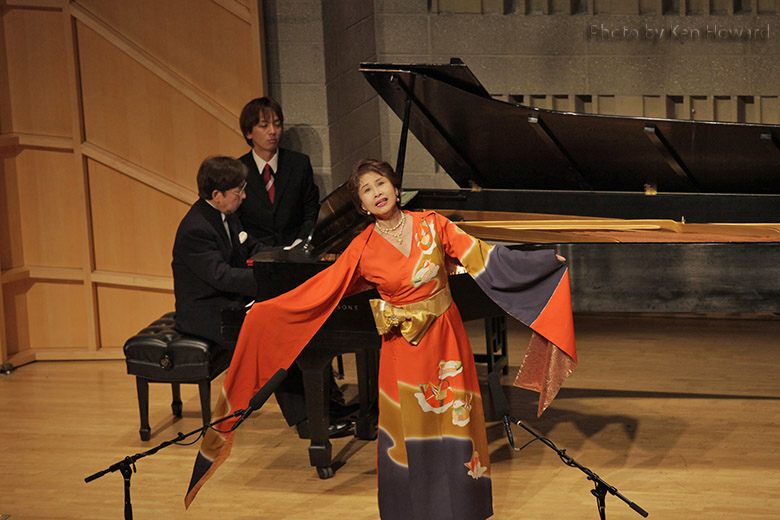
Flutes from the East and the West / Song from the Spirit of Japan
In its 36th season, Music From Japan presented Festival 2011, a weekend of events in New York City’s Baruch Performing Arts Center, and a concert at the Smithsonian in Washington, DC. The programs introduced the worlds of Japanese song and flutes, showcasing the talents of leading exponents of both art forms through traditional and contemporary music. Among the pieces performed were two world premieres commissioned by Music From Japan. In New York the festival presented two programs: “Flutes from the East and the West,” which explored the relationship between these two great musical cultures from multiple perspectives, and “Song from the Spirit of Japan,” which celebrated the nation’s enduring song-setting tradition.
On February 12, 2011, Music From Japan presented Flutes from the East and West, a concert featuring Kohei Nishikawa and Elizabeth Brown performing new and traditional music for Western classical flute and three kinds of Japanese flute: the transverse nohkan and shinobue, as heard in Noh, kabuki theatre, and village festivals, and the shakuhachi, the vertical bamboo flute.
Program
Japanese traditional works for shinobue and nohkan
Traditional: Sanya Sugagaki for shakuhachi and shinobue
Toshiro SARUYA: Stratus for nohkan (1995)
Keiki OKASAKA: Orphuse or Koi no Netori for flute solo (1986) – American premiere
Elizabeth BROWN: fragments for the moon for nohkan and shakuhachi (2010)
– world premiere of new MFJ commission
Yoshihisa TAIRA: Synchronie for flute duo (1986)
On February 13, the festival program was titled Song from the Spirit of Japan. This concert marked the first time Music From Japan programmed a singer as a featured artist; mezzo-soprano Keiko Aoyama is the undisputed “premier performer of Japanese composers’ songs” (Ongaku Gendai [Music Today], Jan 2010). With her regular pianist, Yoshio Tsukada, Aoyama sang settings of traditional folk songs, of songs with traditional Japanese sonorities, and of poems by the popular Hakushu Kitahara (1885-1942), the notable poet and novelist Haruo Sato (1892–1964), and the avant-garde Shoko Ema (1913-2000), one of the few female lyricists of the pre-war period.
Program
Part 1: settings of poems by Shoko EMA
Ikuma DAN: Hana no Machi
Yoshinao NAKADA: Natsu no Omoide
Part 2: settings of poems by Hakusu KITAHARA
Kosaku YAMADA: Kono Michi (This Road)
Kosaku YAMADA: Machibouke
Sinpei NAKAYAMA: Sunayama (Sand Dunes)
Fumihiko FUKUI: Kanpyo
Ikuma DAN: From Three Kouta
– “Haru no Tori” (Birds of Spring)
– “Higanbana”
Kikuko MASSUMOTO: From Six songs on poems by Hakushu Kitahara
– “Night” – American premiere
Part 3: Traditional folk songs and traditional themes
Norio FUKUSHI: Night of the Full Moon for woman’s voice and nohkan (2011)
– world premiere of new MFJ commission
Kan ISHII: Zui Zui Zukkorobashi
Kosaku YAMADA: “Lullaby” from Chugoku Area
Sumiko HIRAI: Rokkyu (lyrics by Hakushu KITAHARA)
Yoshitaka SAKAMOTO: Otemoyan
Michio MAMIYA: Nanbu Ushioiuta
Michio MAMIYA: Shakushi Uriuta (Song of a Rice Paddle Seller)
Part 4: Songs with traditional Japanese sonorities
Kiyoshi NOBUTOKI: Karasu (Crow)
Kikuko MASSUMOTO: From Three songs from Medieval Japan (lyrics: poems from ancient Japan)
– “Hayashi”
– “Shiteten”
Fumio HAYASAKA: “Uguisu” (Nightingale) from Four vocal solos on poems by Haruo Sato
Kunihiko HASHIMOTO: Mai (Dance) (lyrics by Sumako FUKAO)
On February 16, the festival artists travelled to Washington D.C. to perform a concert at the Smithsonian Institution. This concert featured highlights from both festival concerts, including both pieces commissioned by Music From Japan for Festival 2011 – Norio Fukushi’s Night of the Full Moon, and Elizabeth Brown’s fragments for the moon.
Featured artists included Keiko Aoyama: mezzo soprano, Elizabeth Brown: shakuhachi and flute, Kohei Nishikawa: nohkan, shinobue, and flute, and Yoshio Tsukada: piano.
Music from Japan Festival 2011 was made possible in part by public funds from the Agency for Cultural Affairs, Government of Japan, for the fiscal year 2010, the New York State Council on the Arts, a state agency, and the Japan Foundation.
Major funding for the project was provided by the Rohm Music Foundation, The Mitsubishi UFJ Trust Foundation for the Arts, Asahi Shimbun Foundation, The Kao Foundation for Arts and Sciences, Fuji Television Network, Inc., Nomura Foundation, and the Morimura Houmeikai Foundation. Music From Japan appreciates the cooperation of The Japan Federation of Composers, Inc., Japan Society for Contemporary Music, and all participating venues.
© Music From Japan, Inc.

Sukeyasu Shiba’s Gagaku Universe
Music From Japan celebrated its 35th anniversary with Sukeyasu Shiba and his gagaku ensemble, Reigakusha. For this special program Reigakusha performed original and reconstructed works by Mr. Shiba along with a brand new MFJ commission, Mai Fu Jin 35, composed by Mr. Shiba in honor of Music From Japan’s 35th anniversary. The program also featured newly commissioned dance segments to excerpts from Mr. Shiba’s epic, Shotorashion.
Festival 2010 opened on February 20 at Merkin Hall in New York City with Sukeyasu Shiba’s Gagaku Universe. In a preconcert lecture, Mr. Shiba gave a history of Gagaku music. One of the world’s foremost scholars on the subject, Mr. Shiba described the evolution of the music and gave a demonstration on the biwa.
The concert portion of the program began with Guwa No. 1 for shakuhachi and harp, a delicate work in which the distinctive colors of each instrument mix and intermingle progressively throughout the piece. Next, Mr. Shiba treated the audience to his solo ryuteki piece, Ichichyo no Fu. While not overtly virtuosic, the work showcased his nimbleness on the instrument as well his innate musicality as both a performer and a composer. The first half of the concert closed with Reigakusha giving the world premiere of Mai Fu Jin 35. The vivid colors of this work were accentuated by the slow, driving rhythms of the percussion. New York Times critic Allan Kozinn described the work as having “an alluring sound, with the sho providing an appealing drone, the stringed instruments adding texture and the ryuteki providing attractive melodies. Yet it was the music’s rhythmic element — both the intricate patterns played by the individual percussionists, and the way the overall rhythm morphed as the work progressed — that made the strongest impression.”
The second half of the concert began with a quartet of haisho, gaku-so, genkan and o-hichiriki performing a reconstruction of Chosa Join, one of 25 manuscripts for biwa found in cave 17 of the 1000 Buddhist caves at Dun Huang in Western China. Shotorashion closed the program and served as a fitting finale. A work for full gagaku ensemble that featured three new dance segments commissioned by Music From Japan, the piece showcased Reigakusha’s intensity alongside its beauty: the modern dance was choreographed and performed by Stephen Pier, while the mikomai dance was choreographed and performed by Maya Sakai.
After the concert, Music From Japan hosted a reception upstairs for the performers, composers and tomodachi (friends) of Music From Japan.
Highlights of MFJ Commissions II
The second concert Highlights of MFJ Commissions II, given at Merkin Hall on February 21, focused on past commissions by Music From Japan, as well as two new commissions for the occasion. Works by Hikaru Hayashi, Shin-ichiro Ikebe, and Sunao Isaji were revived, and new commissions by Hitomi Kaneko and Yasuko Yamaguchi were premiered by Mayumi Miyata, Hitomi Nakamura and Music From Japan Chamber Ensemble, which comprised pianist Stephen Gosling, cellist Fred Sherry, percussionist Eric Poland, the Cassatt String Quartet and conductor Yasuaki Itakura.
The program began with Hikaru Hiyashi’s Lament, performed by the Cassatt Quartet. The ensemble deftly navigated this work, at once thorny and lush. For the next two pieces, MFJ was lucky enough to have the original ensembles that premiered the works. Eriko Sato and Tom Chiu played Shin-Ichiro Ikebe’s Bivalence for violin duo. Exhibiting great virtuosity, they gave a thrilling performance of this extremely fast-paced and challenging piece. Sunao Isaji’s a lovely day for mirrages on the sea for flute, violin, cello, piano and percussion and conductor closed the first half of the concert. With an almost surreal quality, the work seemed to hover with an imaginary feeling, intoning non-existent languages and rituals.
The second half of the program featured the two works commissioned by MFJ for this year’s festival. The first, Hitomi Kaneko’s Almost Dusk for string quartet and sho, was steeped in timbral variation, exploring first the overtones of the string instruments, then the sho, and finally the two together. Closing the concert, Yasuko Yamaguchi’s Wurzeln, for hichiriki, cello, percussion, piano and conductor, a work in which dashing fragments and glissandi stream into one another and break apart, in a flowing expansion and contraction of sound and melody.
Special Children’s Program at Hunter College Elementary
On Monday, February 22, Music From Japan presented a special children’s program at the Hunter College Elementary School, featuring Reigakusha. The children were introduced to gagaku music with a brief history and a performance of Ponta and the Thunder God, based on the retelling of an old folk tale by Sayumi Kawauchi and set to music by Sukeyasu Shiba. With echoes of “Jack and the Beanstalk”, Ponta tells of a boy whose eggplant seedling produces a plant so huge that he can climb it to reach a mansion beyond the clouds. The students also sang a “shoga”, an oral notation system that is sung to aid in the memorization of melodies. After the concert portion of the program, students learned about the gagaku instruments and several children had the chance to try them out.
Sukeyasu Shiba’s Gagaku Universe in Washington DC
Wrapping up its 35th anniversary season, Music From Japan took Reigakusha to Washington DC for a repeat performance of Saturday’s program. Despite the copious amounts of snow still on the ground, the ensemble played to a sold-out audience at the Smithsonian’s Freer Gallery.
© Music From Japan, Inc.

MASTERS OF TRADITION:
Mojibei Tokiwazu V and his shamisen quartet
Music From Japan opened the New York City portion of its Festival 2009 on March 7 at Merkin Concert Hall with another installment in the Masters of Tradition series. This year’s program, Masters of Tradition: Mojibei Tokiwazu V and his shamisen quartet, featured both traditional and contemporary compositions for the shamisen, a three-stringed, banjo-like instrument. We were very grateful to have Mojibei Tokiwazu V, fifth in a line of distinguished shamisen players, perform with the other members of his quartet: Ichiro Takabatake on jiuta shamisen, Taku Taguchi-Touon on hosozao shamisen, and Sansuzu Tsuruzawa on futozao shamisen.
Before the performance, Mr. Tokiwazu gave an insightful lecture in which he traced the origins of the shamisen to the Middle East and followed its development across Asia to Japan. He then detailed the history of the Tokiwazu style of shamisen playing and its association with Kabuki theatre, with demonstrations on the instrument.
The concert portion of the evening’s program began with Mr. Tokiwazu performing Noriaibune Ehou Manzai (1843), a traditional work for shamisen and voice. The theatrical elements of the Tokiwazu style shone through as he evoked a variety of street characters from the original dance.
Next on the program was Sue no Chigiri, another traditional work for shamisen and voice, performed by Ichiro Takabatake. Couched in a surge of allusion, wordplay, and vivid imagery, Sue no Chigiri is a love song full of longing and hope. Mr. Takabatake’s poignant performance beautifully conveyed the essence of the story.
Closing the first half of the program were selections from Etudes for shamisen duo, composed by Mr. Tokiwazu’s father, Eiju Tokiwazu (Mojibei Tokiwazu IV), in 1962. Despite its name, the work demanded a high degree of virtuosity from its performers, a challenge Mr. Tokiwazu and Mr. Taguchi-Touon were more than capable of meeting.
The second half of the program featured three contemporary works for the full shamisen quartet, two by Mr. Tokiwazu and the third a new Music From Japan commission by Kumiko Omura. Ms. Omura’s work, Dance of Spirits, stems from her earliest childhood recollections of festivals and of dancing the Bonodori, a dance associated with the Buddhist observance of Urabon – a memorial to pray for the spirits of family members who have passed on. In this piece, she evokes the journey through darkness to light as the souls of the dead are saved. Sparse and mysterious at the opening, Dance of Spirits grew little by little into a boisterous and joyous work invoking the festivals and dances that had inspired it.
Mr. Tokiwazu’s offerings – Shamisen Quartet No. 3, “Fête” (2004) and Shamisen Quartet No. 5 (2008) – each maintained strong ties to the tradition while expanding on the vocabulary of the shamisen. Through altered tunings and new rhythmic techniques, the works explored new realms of timbre and motion while preserving their compelling nature.
After the performance, Tomodachi and supporters of Music From Japan were treated to a champagne reception with the performers and other VIPs, as well as the composers from the Tradition/E-novation program.
Tradition/E-novation
The festival continued on Sunday, March 8 with Tradition/ E-novation, a program curated by Mari Kimura, who is as well known for her virtuosic violin playing as for her innovations in the field of interactive performance. The program featured compositions for shamisen, violin, and voice by Ms. Kimura and Tomomi Adachi, both of whom performed, as well as by Mari Takano and Takayuki Rai. Mojibei Tokiwazu V lent his formidable shamisen skills to the performances.
Mr. Tokiwazu opened the program with Tsumoru Koi Yuki no Sekinoto (1784), a staple of the great Tokiwazu repertoire, and expertly performed and narrated this complex tale of love, politics, and human ambition.
Mari Kimura followed with her Subharmonic Partita (2004). One of the many contributions for which Ms. Kimura is recognized is her development of the violin technique known as subharmonics, by which it is possible to play notes below the normal range of the instrument. Using key motives from Bach’s Partita in E-major as the basis for her work, Ms. Kimura took the audience on a whirlwind journey of virtuosity.
Next, Ms. Kimura performed Takayuki Rai’s Active Figuration, a new Music From Japan commission for violin and computer. Mr. Rai’s composition was remarkable in its elegance. Using real-time sampling and analysis technology, the computer generated an impressionistic accompaniment and counterpoint to Ms. Kimura’s violin.
The first half of the program closed with Tomomi Adachi’s epic Odorimbisha, another Music From Japan commission, for shamisen, voices, and live electronics. Mr. Adachi’s work is heavily influenced by both sound poetry and the American Experimentalist tradition, which this piece reflected. Featuring Mr. Tokiwazu and the composer himself, Odorimbisha layered multiple traditions and cultural histories in a fashion at once mystifying and captivating. Moving rapidly between somber and comic modes, the artists gave a highly engaging performance.
The second half of the program featured two more world premieres of new Music From Japan commissions. For Mari Takano’s Full Moon, Mari Kimura performed with an electronic accompaniment consisting of a variety of sound sources, ranging from the purely electronic to samples of her own playing.
Ms. Kimura’s Pluck Land for violin, shamisen, and interactive computer closed Sunday’s program. Centered around the theme of plucked instruments (including both violin and shamisen), the work also showcased the Augmented Violin System, a glove developed by IRCAM and modified by Ms. Kimura that tracks the movements of the violinist’s bowing hand to send control data to a computer, which can then be mapped by the performer to change the sounds.
After the concert, Sharon Nakazato moderated and translated a question and answer session with this year’s commissioned composers. To begin with, each composer explained his or her process and inspiration for composing. The conversation soon turned to the influence of Western music and how each composer balanced Japanese musical tradition and Western influence in their own work.
© Music From Japan, Inc.
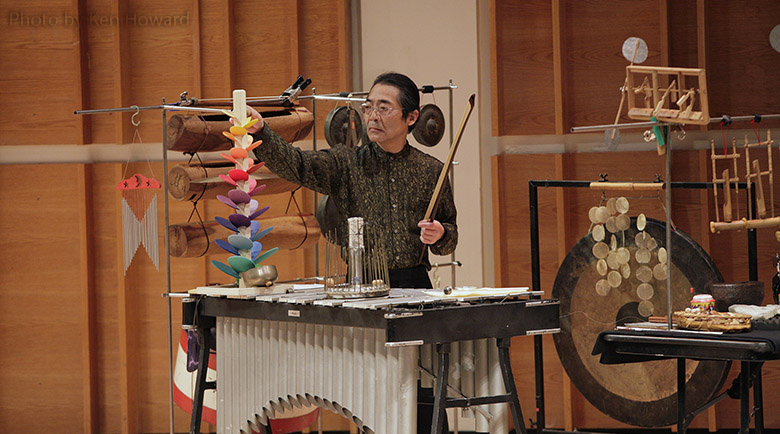
Exploring Ma / Current Sounds: Japan
The Japanese concept of ma was the focus of this presentation. In a pre-concert lecture, Columbia University professor emeritus Donald Keene expounded on the important but often elusive Japanese aesthetic concept of ma, frequently introduced in relation to time and space. Translating literally as “space,” ma has been described by Toru Takemitsu as the “powerful silence” in music. John Cage famously brought this concept to Western attention through works such as 4′ 33″ and One9. Excerpts of One9 were performed by Mayumi Miyata (sho), for whom this piece was originally written. Likewise, Munari by Munari was written especially for percussionist Yasunori Yamaguchi, favored by Takemitsu for his singular timbre. These illustrious artists were joined by Hitomi Nakamura (hichiriki) and Takeshi Sasamoto (ryuteki). The contemporary repertoire, including a work by Hiroya Miura, was juxtaposed with music for winds from the gagaku tradition.
The second program featured a selection of chamber works never before heard in the U.S. from four of Japan’s exciting contemporary composers: Tetsuji Emura, Toshio Nakagawa, Masakazu Natsuda, and Yumi Saiki. While frequently performed in Europe, these composers have received less exposure in the U.S. The program included three world premieres of Music From Japan commissions.
The Exploring Ma: Ancient Winds and Percussion program opened Music From Japan Festival 2008 in New York, NY. It then traveled to Birmingham, AL, Spartanburg, SC and Washington, DC. The gagaku artists then returned to New York for a three-day residency at Columbia University in early March.
© Music From Japan, Inc.
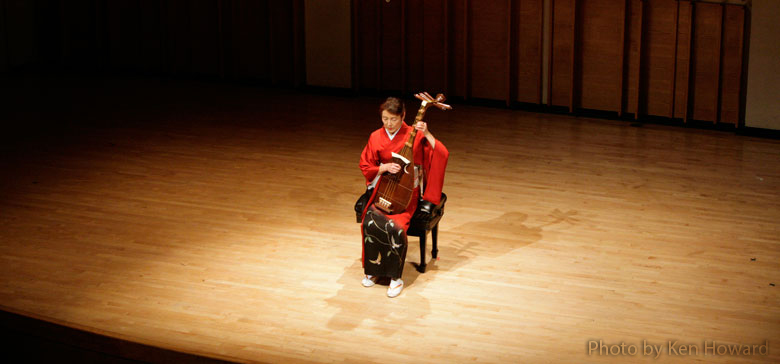
The World of Joji Yuasa
On March 4, 2007, at Merkin Concert Hall, Music From Japan celebrated its 32nd year with The World of Joji Yuasa. A self taught composer, Mr. Yuasa started his career in the group “Experimental Workshop” (Jikken Kobo) with Toru Takemitsu and others in the early 1950’s. He has received numerous awards, including those for his radio, television, and film scores. In his composing, he has sought a primordial and universal language that transcends culture. Before the concert Mr. Yuasa gave the New York audience a greater understanding of this language and its development through a pre-concert lecture, The Music and Life of Joji Yuasa, and the concert program, The Works of Joji Yuasa. The concert included works from his early years as well as more recent compositions along with a piece commissioned by Music From Japan for the event.
The Junko Tahara Ensemble
The concert program of The Junko Tahara Biwa Ensemble featured selections from The Tale of Heike, a medieval literary work chronicling a pivotal period in Japanese history. Beginning in the 12th century, the tale became part of an oral-musical tradition in which biwa music was interwoven with narration. Ms. Tahara has moved this tradition in a new direction by basing her compositions on Tomiko Miyao’s version of the tale which takes a woman’s perspective on the events of the epoch. The program will also feature instrumental work including a newly commissioned piece by Masataka Matsuo. Ms. Tahara studied Chikuzen biwa under Mikako Yamada and the living national treasure Kyokusui Yamazaki. Since 1972, she has been a principal member of the world famous ensemble Pro Musica Nipponia.
Festival 2007 – U.S. Tour
Festival 2007 opened in Washington, DC with the US tour of the The Junko Tahara Biwa Ensemble. The musicians then traveled to Murfreesboro, TN before arriving in New York. Educational programming, lead by Ms. Tahara, accompanied the performances to bring a greater understanding of the biwa and katarimono, narrated songs in Japan’s oral tradition, to American audiences. Barbara Ruch, Director of the Institute of Medieval Japanese Studies at Columbia University and Professor Emeritus of Japanese Literature and Culture, gave a pre-concert lecture in New York City on medieval Japan and the significance of The Tale of Heike. The final performance of the tour was given at the Yasuragi Center in Mahopac, NY.
© Music From Japan, Inc.

Masters of Tradition:
Akikazu Nakamura, shakuhachi
Music From Japan presented two concert programs during its 31st season. The first focused on the Japanese bamboo flute, the shakuhachi. Festival 2006 opened on February 11 at Merkin Concert Hall with Akikazu Nakamura on shakuhachi and Michiyo Yagi on 20-string koto. The program of traditional and contemporary works featured the world premiere of a MFJ-commission by Masao Endo. A pre-concert talk by Ralph Samuelson examined the shakuhachi today.
Young Japanese Composers II
Festival 2006 continued with the New Works by Young Japanese Composers series (begun in 2003). New Yorkers had the opportunity to hear the newest sounds composed by Naoko Hishinuma, Miyuki Ito, Hiroyuki Itoh, Motoharu Kawashima and Hiroyuki Yamamoto.
A program of world premieres commissioned by Music From Japan was performed on February 12 at Merkin Hall by leading New York musicians conducted by Carolyn Kuan. The visiting composers were present for a discussion, which followed the concert.
The shakuhachi program was presented again at Yasuragi Center in Mahopac, New York, at Middle Tennessee State University in Murfreesboro, Tennessee, and at Converse College in Spartanburg, South Carolina. The Festival came to a close with a special program at the Freer Gallery, Smithsonian Institution in Washington, DC to celebrate the 100th anniversary of Charles Lang Freer’s donation of his collection.
© Music From Japan, Inc.
